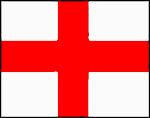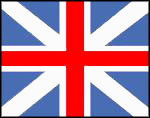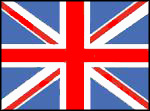-

Historic Jamestowne
History of the British Flag
In 1603, the year of Queen Elizabeth I's death, England and Scotland existed as completely separate nations, each with their own monarch and parliament. Elizabeth, being a spinster and therefore childless, expressed a deathbed wish that her cousin, King James VI of Scotland, be named as her successor to the English throne. Thus, the Scottish monarch was projected into the unique position of ruling two nations simultaneously. He ruled Scotland as King James VI and England as King James I.
English National FlagThe English national flag at this period consisted of a simple red cross fully imposed upon a plain white field, this being the emblem of St. George, England's patron saint. The Scottish national flag consisted of a diagonal, or X-shaped, white cross, fully imposed upon a medium blue field. This was the emblem of St. Andrew, Scotland's patron saint. In the spring of 1606, to symbolize the monarchical unification of the two nations under himself, James created a banner to this end, by fully superimposing the English red cross (with a narrow white border to represent its normal white field) upon the Scottish flag. This became known as the Union Flag, and it was the forerunner of the present flag of Great Britain.
Scottish National FlagIn the decree of issuance of the new flag, James stipulated that all ships of both English and Scottish registry were to fly this flag from atop their mainmasts. The Cross of St. George was to be flown from the foremasts of the English ships, while the Cross of St. Andrew was to be flown form the foremasts of the Scottish ships. As the Susan Constant, Godspeed and Discovery were of English registry and did not embark upon their historic voyage until December of 1606, it logically follows that on this voyage their flags conformed to the royal decree of the preceding spring.
Union Flag 1606-1801The Union Flag, created by James in 1606, continued in use as a purely symbolic banner until 1707. Then, during the reign of Queen Anne, the parliaments of England and Scotland were united to form the new nation of Great Britain, and Anne officially adopted the 101 year old banner as the national flag of the newly created nation. In 1801, when Ireland became a part of Great Britain, the Union Flag was redesigned to include the Cross of St. Patrick (red, diagonal), the patron saint of Ireland. It is in this form that the British flag exists today.
Irish National Flag
United Kingdom flag of Great Briton todayDid You Know?
Atlantic Sturgeon were over-fished in the 1890’s,coupled with a decline in water quality,the population is now greatly reduced;Atlantic Surgeon are now a protected species. The James River is the only river in the Chesapeake region with a confirmed breeding population.